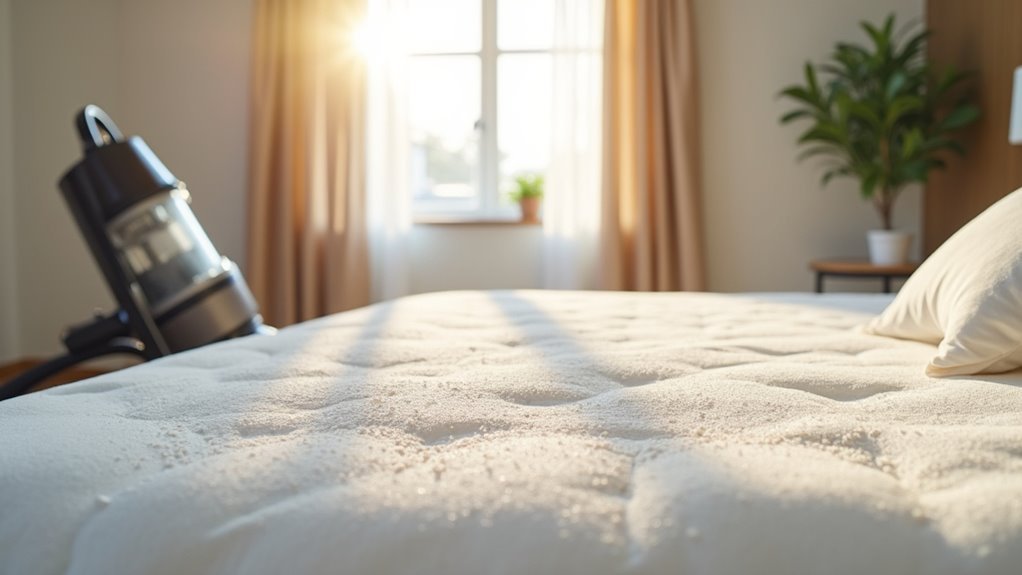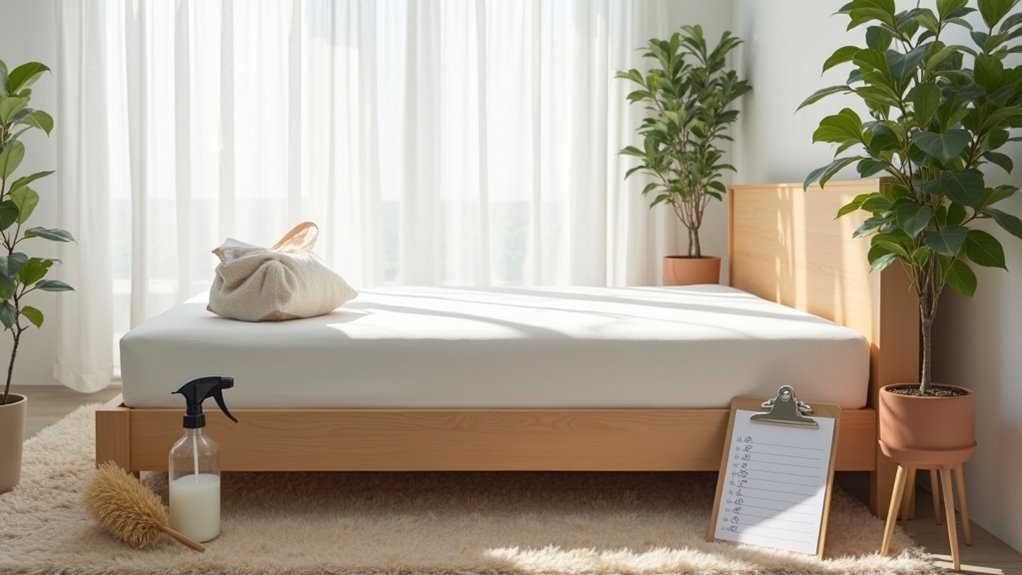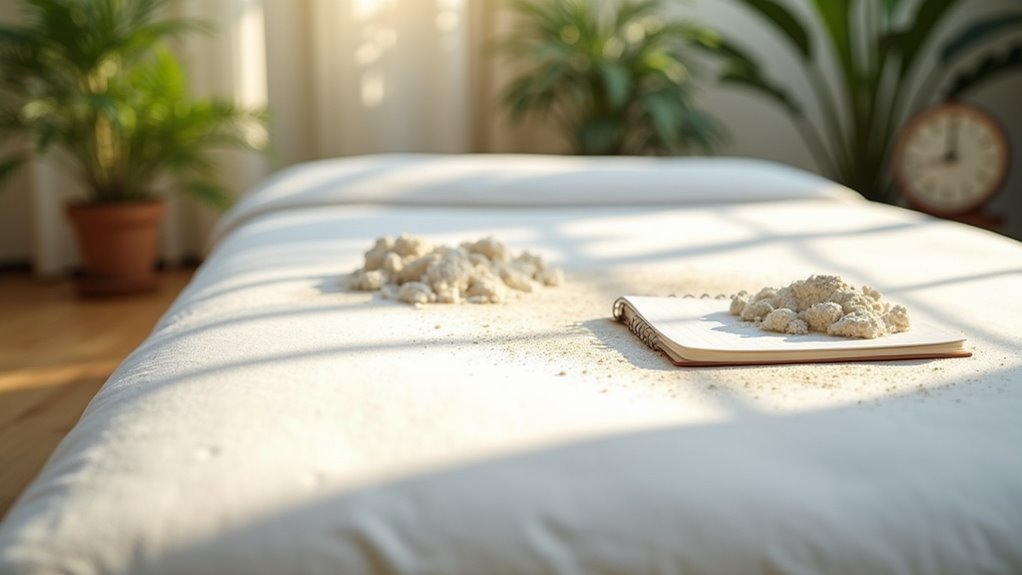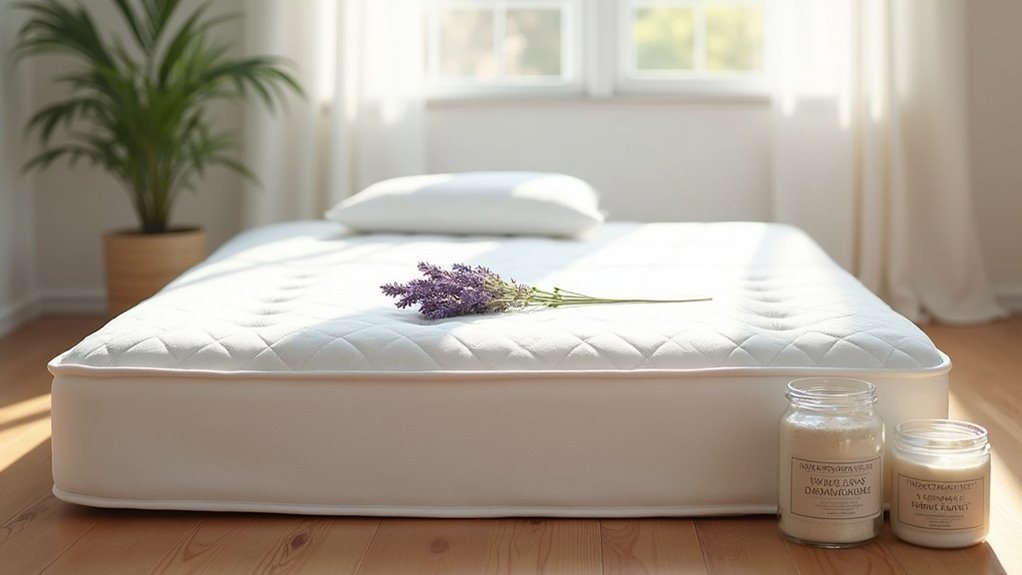You’ll need food-grade diatomaceous earth with at least 7.2% silicon dioxide to effectively treat your mattress for bed bugs. Start by washing all bedding in hot water, then vacuum your mattress thoroughly, focusing on seams and crevices. Wear protective gear and apply a thin, even layer of DE across the entire surface, working it into the fabric. Monitor for 7-17 days as the desiccant dehydrates bed bugs through direct contact. This systematic approach reveals extensive strategies for complete elimination.
What Is Diatomaceous Earth and How Does It Kill Bed Bugs

Bed bugs meet their match when they encounter diatomaceous earth, a fine powder made from fossilized remains of microscopic marine algae called diatoms.
This silicon dioxide-based substance works as a powerful desiccant that’ll kill bed bugs through dehydration. When you apply diatomaceous earth, it disrupts the waxy outer coating of bed bugs’ exoskeletons, causing fatal moisture loss.
DE requires direct contact to be effective as a bed bug treatment. The abrasive particles must stick to the insect’s body to work properly.
You’ll see results within 7 to 17 days after exposure. However, diatomaceous earth won’t eliminate bed bug eggs, so you’ll need consistent application for at least 15 days to catch newly hatched bugs and achieve complete eradication.
Essential Safety Precautions Before Starting Treatment
Before you begin treating your mattress with diatomaceous earth, you’ll need to prioritize your safety by selecting the right product and protective gear.
You must use only food-grade diatomaceous earth, as pool-grade varieties contain dangerous crystalline silica that can cause serious respiratory damage.
Don’t start the application process without wearing a dust mask, gloves, and ensuring proper ventilation in the room.
Choose Food Grade DE
Safety becomes your top priority when selecting diatomaceous earth for mattress treatment, and you’ll want to choose only food grade diatomaceous earth for this task.
Unlike pool or garden varieties, food grade DE is non-toxic and safe around pets and children, making it the perfect solution for your bed bug infestation.
When shopping for food grade DE, follow these essential criteria:
- Verify the crystalline silica content – Choose products containing less than 1% crystalline silica to minimize health risks.
- Check product labeling – Confirm it’s specifically marked as “food grade” rather than industrial or pool grade.
- Select reputable brands – Purchase from trusted manufacturers who provide safety certifications.
Once you apply diatomaceous earth correctly, you’ll have an effective, safe treatment that protects your family while eliminating bed bugs.
Wear Protective Equipment
Three essential pieces of protective equipment will safeguard your health during diatomaceous earth application. You’ll need a dust mask to prevent respiratory issues from inhaling particles, gloves to protect against skin irritation, and protective eyewear to shield your eyes from airborne dust.
| Equipment | Purpose |
|---|---|
| Dust Mask | Prevents inhalation of particles |
| Gloves | Protects skin from dryness/irritation |
| Safety Glasses | Shields eyes from dust particles |
Before you wear protective equipment, verify you’re using food-grade diatomaceous earth for safer indoor application. Pool or garden grades pose greater health risks. Keep children and pets away from treated areas until the DE settles completely. Don’t skip this preparation step—proper protection guarantees your mattress treatment remains safe and effective.
Avoid Pool Grade Products
When selecting diatomaceous earth for your mattress treatment, you must distinguish between food-grade and pool-grade varieties to protect your health.
Pool grade DE undergoes calcination, creating harmful crystalline silica that poses serious risks to your respiratory system and skin. This toxic version can cause breathing problems and irritation when used indoors.
To guarantee your safety, follow these essential guidelines:
- Choose only food grade diatomaceous earth labeled specifically as “food grade” or “pet grade”
- Read product labels carefully to verify the absence of pesticides and harmful additives
- Never use pool grade DE indoors as it’s designed for filtration, not pest control
Food grade diatomaceous earth effectively controls bed bugs without compromising your health, making it the only safe choice for mattress treatment.
Choosing the Right Type of Diatomaceous Earth for Your Mattress
You’ll need to select food-grade diatomaceous earth rather than pool-grade varieties, as pool-grade DE is calcined and contains dangerous crystalline silica that’s harmful to breathe.
Check that your chosen DE contains at least 7.2% silica dioxide content to guarantee it’s effective against bed bugs.
Always avoid calcined DE products since they’re processed at high temperatures and pose serious health risks when used indoors.
Food Grade Vs Pool Grade
While both food grade and pool grade diatomaceous earth might look identical, choosing the wrong type for your mattress treatment can put your health at serious risk.
Food grade diatomaceous earth contains less than 1% crystalline silica, making it safe for use around humans and pets. Pool grade DE, however, contains dangerous levels of crystalline silica that can cause serious respiratory issues.
Here’s why food grade DE is your only safe option:
- Safety First: Food grade is specifically processed to remove harmful crystalline silica content.
- Pest Control Effectiveness: It’s effective in dehydrating bed bugs while protecting the health of individuals and pets.
- Indoor Application: Unlike pool grade, it’s designed for indoor use in sleeping areas.
Always verify the product label shows “food grade” before treating your mattress.
Silicon Dioxide Content Requirements
The concentration of silicon dioxide in your diatomaceous earth determines its effectiveness against bed bugs crawling through your mattress.
You’ll need food grade diatomaceous earth with a minimum silicon dioxide content of 7.2% for effective pest control. This concentration provides the abrasive and absorbent properties necessary for killing bed bugs by disrupting their exoskeletons and causing dehydration.
When selecting your DE product, verify the label confirms it’s non-toxic, non-calcined, and specifically food-grade quality.
Industrial or calcined versions pose serious health risks in home environments. The proper silicon dioxide content guarantees your treatment remains safe around children and pets while delivering lethal results against bed bug infestations within 7 to 17 days of consistent application.
Avoiding Calcined DE Products
Most homeowners don’t realize that selecting the wrong type of diatomaceous earth can transform an effective bed bug treatment into a dangerous health hazard.
Calcined DE poses serious respiratory and skin irritation risks, making it completely unsuitable for mattress applications. You’ll need food-grade diatomaceous earth for safe, non-toxic bed bug control.
Here’s what to avoid when shopping:
- Pool-grade DE – Contains toxic crystalline silica that’s harmful when inhaled
- Calcined diatomaceous earth – Heat-treated products designed for industrial filtration, not pest control
- Unlabeled products – DE without clear food-grade certification or pest control designation
Properly using diatomaceous earth starts with choosing uncalcined, food-grade varieties.
These maintain natural properties while ensuring your family’s safety during treatment.
Tools and Materials Needed for Effective Application
Before you begin treating your mattress with diatomaceous earth, gather several essential tools that’ll guarantee safe and effective application.
You’ll need a dust mask to prevent inhalation of particles and gloves to protect your skin during handling. A pesticide duster assures even distribution across your mattress surface while minimizing airborne particles.
For precise application, use a plastic measuring spoon or cup to scoop controlled amounts of diatomaceous earth.
Keep a screwdriver handy to remove electrical faceplates and light switch covers, allowing you to treat hard-to-reach areas where bed bugs might hide.
Store your diatomaceous earth in a re-sealable container to maintain its effectiveness and prevent moisture absorption between treatments.
Room Preparation and Pre-Treatment Steps

Once you’ve assembled your application tools, preparing your bedroom becomes the critical foundation for successful diatomaceous earth treatment. Proper room preparation directly impacts how effectively you’ll eliminate bed bugs from your sleeping area.
Your pre-treatment checklist includes these essential steps:
- Wash and seal all bedding in hot water, then store unused items in plastic bags to prevent re-infestation during treatment.
- Remove clutter and soft furnishings from the room, ensuring you’ll have clear access to all potential bed bug hiding spots.
- Vacuum thoroughly around the mattress, bed frame, and surrounding areas to eliminate existing bugs and eggs before applying diatomaceous earth.
Pull your bed away from walls and dispose of vacuum contents outside immediately. This prevents any escaping bed bugs from re-establishing themselves in your home.
Step-by-Step Mattress Application Process
You’ll need to prepare your mattress properly before applying diatomaceous earth to guarantee maximum effectiveness against bed bugs.
The application technique requires careful attention to coverage and penetration into hiding spots where bed bugs typically nest.
After treatment, you must monitor the area consistently and maintain the DE barrier through strategic reapplication over the following weeks.
Pre-Treatment Mattress Preparation
Proper preparation sets the foundation for successful diatomaceous earth treatment against bed bugs. Before applying this natural pesticide, you’ll need to create ideal conditions for maximum effectiveness.
Here’s your pre-treatment checklist:
- Strip and wash all bedding – Remove sheets, pillowcases, and mattress covers, then wash everything in the hottest water setting to eliminate existing bed bugs and their eggs.
- Vacuum thoroughly – Use your vacuum to clean the mattress surface, paying special attention to seams, folds, and crevices where bed bugs typically hide.
- Create workspace – Pull your mattress away from the bed frame to guarantee you can access the entire perimeter for complete food-grade diatomaceous earth application.
This preparation guarantees your treatment reaches every potential hiding spot.
DE Application Technique
Apply diatomaceous earth with precision to maximize its bed bug elimination power.
Start the application process by putting on protective gear – dust mask and gloves are essential. Sprinkle a thin layer of food-grade diatomaceous earth evenly across your mattress surface, paying special attention to seams and crevices where bed bugs typically hide.
Use a brush or duster to work the DE deep into the mattress fabric, ensuring you reach every corner and edge.
Don’t rush this step – thorough coverage determines your success rate. Let the treatment sit for 7-17 days while monitoring bed bug activity.
During this period, you’ll need regular vacuuming of disturbed areas and reapplication of diatomaceous earth as necessary for ideal results.
Post-Application Monitoring Steps
Once you’ve completed the diatomaceous earth application, monitoring becomes your most critical task for determining treatment success. Your vigilance during the next 7-17 days will reveal whether the treatment’s working effectively.
Here’s your monitoring protocol:
- Document everything daily – Keep a detailed log of bite occurrences, visual bed bug sightings, and time since your initial diatomaceous earth application to track progress accurately.
- Monitor mattress weekly – Inspect your mattress and surrounding areas for signs of bed bug activity, including live bugs, blood spots, or fecal stains that indicate ongoing infestation.
- Vacuum treated areas strategically – Remove dead bugs and disturbed DE weekly, but don’t overdo it or you’ll compromise the protective barrier.
When bed bug activity persists, reapply diatomaceous earth immediately after vacuuming to maintain effectiveness.
Creating Protective Barriers Around Your Sleeping Area
When bed bugs threaten your peaceful sleep, establishing protective barriers around your sleeping area becomes your first line of defense.
Start by spreading a thin layer of food-grade diatomaceous earth around your room’s perimeter, focusing on baseboards and entry points where these pests typically enter.
Apply DE strategically in cracks and crevices, particularly where walls meet floors and behind electrical face plates. This disrupts bed bugs’ travel routes effectively.
Create a thick barrier around your bed by sprinkling diatomaceous earth on the floor and bed frame, preventing bugs from climbing onto your mattress.
Reapply every seven days to maintain effectiveness, especially after vacuuming.
Use a duster for even application while avoiding excessive dust clouds that could cause respiratory irritation.
Monitoring Progress and Timeline Expectations

Understanding the timeline for diatomaceous earth effectiveness helps set realistic expectations for your bed bug treatment journey.
Your diatomaceous earth treatment plan requires patience, as this natural method doesn’t work instantly like chemical pesticides.
Unlike chemical pesticides that work immediately, diatomaceous earth requires patience as this natural treatment method takes time to eliminate bed bugs effectively.
Timeline expectations for monitoring progress:
- Days 1-7: Continue sleeping on your mattress to attract bed bugs to the DE barriers while watching for new bites that may take several days to appear due to molting cycles.
- Days 7-17: Vacuum treated areas weekly and reapply DE as needed, since this is when most bed bugs will die after initial exposure.
- Weeks 3-4: Extend monitoring because DE doesn’t kill eggs, so newly hatched bed bugs need time to contact the treatment and perish.
Reapplication Schedule and Maintenance Tips
Since diatomaceous earth loses its potency when disturbed or scattered, you’ll need to establish a consistent reapplication schedule to maintain effective bed bug control. Reapply diatomaceous earth every seven days, as bed bugs require 7-17 days to die after exposure.
| Maintenance Task | Frequency |
|---|---|
| Reapply DE to treated areas | Every 7 days |
| Vacuum excess DE from high-traffic zones | Weekly |
| Wash bedding in hot water | Every 3-4 days |
| Monitor for bed bug signs | Daily |
Vacuum excess DE regularly to prevent airborne particles while preserving diatomaceous earth effectiveness. Monitor for signs of bed bug activity like bites or sightings between applications. Keep mattress areas undisturbed after treatment, and maintain a clean environment by sealing unused items to prevent re-infestation.
Combining Diatomaceous Earth With Other Treatment Methods
Although diatomaceous earth effectively kills adult bed bugs through contact, you’ll achieve superior results by combining it with complementary treatment methods that address the pest’s entire life cycle.
Integrating diatomaceous earth with heat treatments creates a powerful one-two punch. While DE targets crawling adults, heat eliminates eggs that DE can’t destroy. You’ll maximize effectiveness by pairing these pest control approaches.
Consider these essential combination strategies:
- Heat + DE Application: Use ZappBug heaters alongside diatomaceous earth treatments to kill both adults and eggs simultaneously.
- Encasements + DE Barriers: Install mattress encasements while sprinkling DE around bed frames to create thorough protection.
- Regular Vacuuming + Monitoring: Combine weekly vacuuming with DE reapplication and trap placement for ongoing surveillance.
This integrated approach guarantees you’re addressing bed bugs at every vulnerable stage while maintaining long-term protection.
Post-Treatment Cleanup and Prevention Strategies
Once your diatomaceous earth treatment has eliminated the bed bug infestation, you’ll need to execute a systematic cleanup process to remove residual DE while establishing protective barriers against future invasions.
Use your vacuum cleaner weekly to remove disturbed diatomaceous earth and monitor for bed bug activity. Seal gaps in walls, baseboards, and electrical outlets where bed bugs might enter.
Weekly vacuuming removes diatomaceous earth residue while sealing wall gaps and electrical outlets prevents bed bug re-entry into treated areas.
Wash bedding in hot water and dry on high heat to eliminate remaining pests. Minimize bedroom clutter to reduce hiding spots.
Install mattress encasements specifically designed to trap bed bugs and block access to your mattress and box spring.
These prevention measures create multiple defensive layers that’ll help prevent re-infestation and maintain your bed bug-free environment long-term.
Frequently Asked Questions
How Long Should I Leave Diatomaceous Earth on My Bed for Bed Bugs?
You should leave diatomaceous earth on your bed for 7 to 17 days minimum. This timeframe allows it to effectively dehydrate and kill bed bugs that come into contact with the powder.
How to Apply Diatomaceous Earth on a Mattress?
Wear gloves and a dust mask, then sprinkle a thin, even layer of food-grade diatomaceous earth across your mattress surface. Focus on seams, edges, and corners where bed bugs typically hide.
What Are the Downsides of Diatomaceous Earth?
You’ll face respiratory irritation if you don’t wear protection, wait weeks for results, need multiple applications since it doesn’t kill eggs, and experience reduced effectiveness in humid conditions.
Do I Vacuum After Using Diatomaceous Earth?
Yes, you should vacuum after using diatomaceous earth. Wait at least seven days first, then vacuum weekly to remove excess powder and dead bugs. Dispose of vacuum contents away from home.
In Summary
You’ve now got a thorough diatomaceous earth treatment plan that’ll effectively eliminate bed bugs from your mattress. Remember, consistency is key – don’t skip reapplications and always monitor your progress. While DE is powerful on its own, you’ll see faster results when you combine it with other methods. Stay patient, follow safety protocols, and maintain preventive measures. With dedication and proper execution, you’ll reclaim your bed and enjoy peaceful, bug-free sleep again.





Leave a Reply